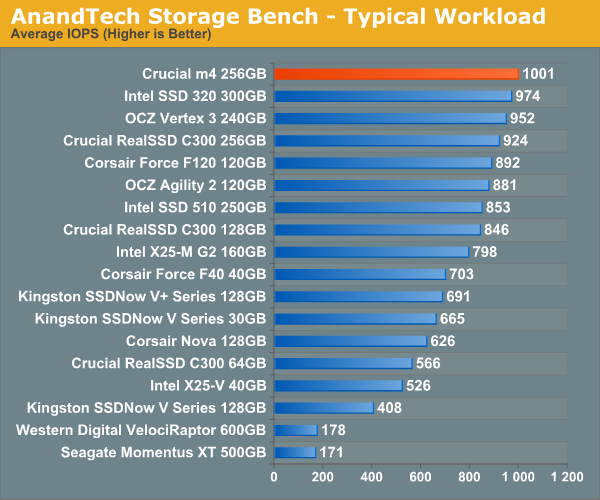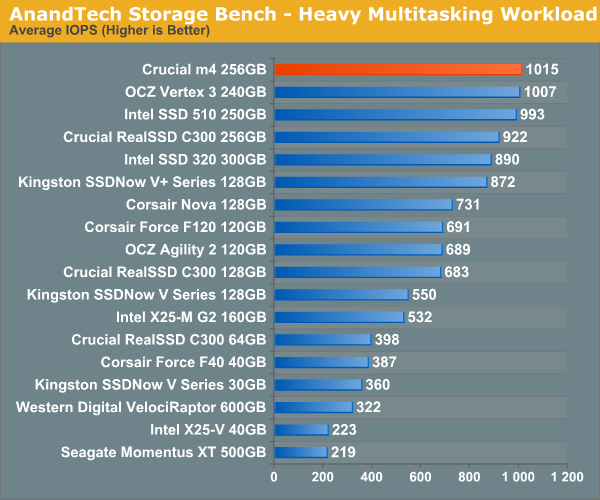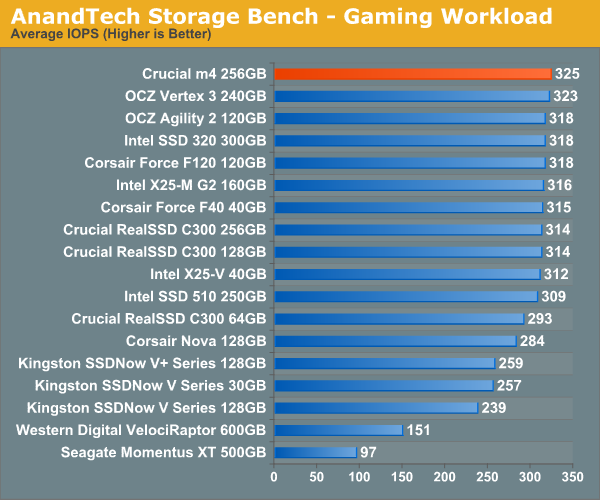The Crucial m4 (Micron C400) SSD Review
by Anand Lal Shimpi on March 31, 2011 3:16 AM ESTAnandTech Storage Bench 2010
To keep things consistent we've also included our older Storage Bench. Note that the old storage test system doesn't have a SATA 6Gbps controller, so we only have 3Gbps results for the 6Gbps drives.
The first in our benchmark suite is a light/typical usage case. The Windows 7 system is loaded with Firefox, Office 2007 and Adobe Reader among other applications. With Firefox we browse web pages like Facebook, AnandTech, Digg and other sites. Outlook is also running and we use it to check emails, create and send a message with a PDF attachment. Adobe Reader is used to view some PDFs. Excel 2007 is used to create a spreadsheet, graphs and save the document. The same goes for Word 2007. We open and step through a presentation in PowerPoint 2007 received as an email attachment before saving it to the desktop. Finally we watch a bit of a Firefly episode in Windows Media Player 11.
There’s some level of multitasking going on here but it’s not unreasonable by any means. Generally the application tasks proceed linearly, with the exception of things like web browsing which may happen in between one of the other tasks.
The recording is played back on all of our drives here today. Remember that we’re isolating disk performance, all we’re doing is playing back every single disk access that happened in that ~5 minute period of usage. The light workload is composed of 37,501 reads and 20,268 writes. Over 30% of the IOs are 4KB, 11% are 16KB, 22% are 32KB and approximately 13% are 64KB in size. Less than 30% of the operations are absolutely sequential in nature. Average queue depth is 6.09 IOs.
The performance results are reported in average I/O Operations per Second (IOPS):

Lighter read-heavy workloads do very well on the m4. Thankfully for Crucial, most user workloads tend to be very read intensive. Over a 3Gbps interface, the m4 is a bit faster than Intel's 320 in our typical workload from 2010.
If there’s a light usage case there’s bound to be a heavy one. In this test we have Microsoft Security Essentials running in the background with real time virus scanning enabled. We also perform a quick scan in the middle of the test. Firefox, Outlook, Excel, Word and Powerpoint are all used the same as they were in the light test. We add Photoshop CS4 to the mix, opening a bunch of 12MP images, editing them, then saving them as highly compressed JPGs for web publishing. Windows 7’s picture viewer is used to view a bunch of pictures on the hard drive. We use 7-zip to create and extract .7z archives. Downloading is also prominently featured in our heavy test; we download large files from the Internet during portions of the benchmark, as well as use uTorrent to grab a couple of torrents. Some of the applications in use are installed during the benchmark, Windows updates are also installed. Towards the end of the test we launch World of Warcraft, play for a few minutes, then delete the folder. This test also takes into account all of the disk accesses that happen while the OS is booting.
The benchmark is 22 minutes long and it consists of 128,895 read operations and 72,411 write operations. Roughly 44% of all IOs were sequential. Approximately 30% of all accesses were 4KB in size, 12% were 16KB in size, 14% were 32KB and 20% were 64KB. Average queue depth was 3.59.

Last year's heavy multitasking workload was also predominantly read heavy. The m4 does very well here again, roughly equaling the performance of OCZ's Vertex 3.
The gaming workload is made up of 75,206 read operations and only 4,592 write operations. Only 20% of the accesses are 4KB in size, nearly 40% are 64KB and 20% are 32KB. A whopping 69% of the IOs are sequential, meaning this is predominantly a sequential read benchmark. The average queue depth is 7.76 IOs.

Gaming performance is good but we're of course bottlenecked by the 3Gbps SATA interface in this test.










103 Comments
View All Comments
Nentor - Thursday, March 31, 2011 - link
"And for those of you asking about my thoughts on the recent OCZ related stuff that has been making the rounds, expect to see all of that addressed in our review of the final Vertex 3."Too late Anand and you well know it. It has no place hidden in some unwritten review about next generation hardware either.
I don't think people talking about that matter are that concerned with your thoughts on it, but about you speaking out on a product you reviewed that turned out to be very good and now is available in shops in the same box and shell but with different hardware inside and performance.
Anyone might end up buying one of these things based on your good review of it and end up with quite another product when they return home.
That is the point and you failed it quite horribly professionally and personally.
Anand Lal Shimpi - Thursday, March 31, 2011 - link
The 25nm fiasco happened while I was out of the country covering MWC. I was thousands of miles away from any testbeds. When it happened I immediately contacted OCZ's CEO and asked for his plan to make it right. To date I believe they have addressed all present concerns by allowing users to exchange drives with 64Gbit 25nm NAND for 32Gbit drives. It's my understanding that small capacity 64Gbit die drives have been discontinued. There are still some 64Gbit devices in the channel and I pushed for a name change on the impacted product but it looks like the best OCZ is willing to do is point you at the model number to (possibly) determine what you're getting.I finally got a pair of 25nm drives in this week - I wasn't going to make any public statements based on product I haven't tested personally. Unfortunately both drives, the 60GB 'E' and 120GB non-E use 32Gbit NAND devices.
OCZ shouldn't have handled this the way it did initially. Lower performing drives should never have hit the market and they shouldn't have tried to charge people for replacements. However the company did respond quickly and I believe has made things right for those users who are impacted based on what I've seen here:
http://www.ocztechnologyforum.com/forum/showthread...
Regardless this is another check in the wrong column for OCZ and it will be addressed - not hidden - (as well as the SpecTek memory stuff) in an upcoming article. My original plan was to wrap that, the m4, Corsair P3 and Samsung 470 all into our Intel 320 review however being at CTIA last week left me with little time to get all of that done.
I would've liked to have been on top of all of this from the start, and had OCZ not made things right publicly early on I would've stepped in (there was a lot of prodding from me behind the scenes during MWC week). The timing was unfortunate and I'm looking to bring on a regular storage editor to help ensure this sort of thing doesn't happen in the future. With all of the growth in SSDs as well as the increase in demand for HDD coverage, it's time to grow the storage team on AT.
Take care,
Anand
cactusdog - Thursday, March 31, 2011 - link
Anand, OCZ have only made things partially right, the issue is not solved. Ocz are swapping drives to meet IDEMA specs but performance is still slower. So they only made it 50% right.Its not the fact that its a slower drive, but they are using the same branding then making it impossible for users to know which nand is being used before the drive is purchased.
The bigger issue is if it is ethical for a company to change specs and use the same branding. Afterall, Intel and Corsair saw fit to rebrand their 25nm drives. Other companies at least changed the model number.
The spectek issue is another can of worms for ocz but it raises the same kind of questions about Ocz ethics and transparency.
Anand Lal Shimpi - Thursday, March 31, 2011 - link
This is why I wanted to get drives in house. With 25nm 120GB and 60GB drives in hand now I can start looking at performance. In theory with the same number of die there shouldn't be any performance difference. If there is, something else is at play.It is absolutely unethical for a manufacturer to change performance and sell under the same product name. Let me do some testing and I'll touch on this very soon.
Take care,
Anand
Gami - Thursday, March 31, 2011 - link
the problem with you new test is which drives are you getting..The first version of the 25nm SSDs that they tried to secrectly get through..
or the final version after all the complaints and the switch to the bigger nand chips..
the very first ones, they used only used 8 channels to connect those nand chips.. you need to get one of these drives as well..
after all the complaints, they finally admitted what they done, and said you could trade in for proper sized SSDs but you had to pay a different in price, even though you already paid for what you're finally being given..
after another run of bad press and complaints, they backed off the whole pay the different and just gave you a new SSD witht he right configs.
it's still less space and less performance than the original Vertex2 that you originally bought.. and also has less of a life span.
(if you had bought these the first few months of the change to 25nm, you were also paying the full price of the 32nm chips) there was no savings, you paid more for a worthless new SSD that had the same markings on it, as the one that was rated number one SSD for the year.
mikato - Friday, April 1, 2011 - link
"However the company did respond quickly and I believe has made things right for those users who are impacted based on what I've seen here"Actually, it looks like they only made things right for the people that noticed they were tricked a bit and complained. One might argue that there was no impact to those who didn't notice since hey, they got an OCZ Vertex 2 didn't they, but most of us wouldn't agree with that because they could put a Vertex 2 label on a box of dog crap if they wanted.
FWIW I bought a Vertex 2 120GB in early January. I'm happy with it and I'm pretty sure it's not 25nm based on what I've read for the releases etc. but I haven't checked on it myself with any test. If it turned out to be 25nm and with worse specs, I probably won't return it to avoid the hassle but that doesn't mean I didn't get shortchanged.
anevmann - Thursday, March 31, 2011 - link
"seequential" in the Performance vs transfer size :PBut a great ssd review as always Anand ;)
Anand Lal Shimpi - Thursday, March 31, 2011 - link
Thanks for the comment and the heads up :)Take care,
Anand
anevmann - Thursday, March 31, 2011 - link
Any news when/if TRIM will be supported in raids in the future?forgotdre - Thursday, March 31, 2011 - link
samsung 470 review please! I haven't heard much about it and it seems like a great drive!